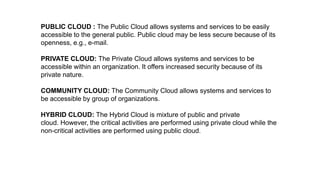Cloud Computing By Amaan Khan.pptx
- 1. Cloud Computing Presented By- AMAAN KHAN B-TECH3rd YEAR 1190432025
- 2. Cloud Computing Introduction What is Cloud? What is Cloud Computing? Cloud Computing Architecture 01 Basic Model Deployment Model Service Model 02 Advantage & Disadvantage 03 Cloud Storage 04
- 3. 101001101001000010101 0011110111011011011010 101000011100101011001 010100111010100010101 0001011010110110110100 010101110001010100010 1000101110101100010011 010011010010000101010 0111101110110110110101 010000111001010110010 101001110101000101010 0010110101101101101001 INTRODUCTION Cloud Computing With Cloud Computing users can access database resources via internet from anywhere for as long as they need without worrying about any maintenance or management of actual resources. Cloud Computing provides us means by which we can access the applications as utilities, over the Internet. It allows us to create, configure, and customize application online.
- 4. 101001101001000010101 0011110111011011011010 101000011100101011001 010100111010100010101 0001011010110110110100 010101110001010100010 1000101110101100010011 010011010010000101010 0111101110110110110101 010000111001010110010 101001110101000101010 0010110101101101101001 What is Cloud? The term Cloud refers to a Network or Internet. In other words, we can say that’s Cloud is something. Which is present at remote location. Cloud can provide services over network, i.e., on public network or on private network, i.e., WAN,LAN or VPN. Applications such as e-mail, web conferencing, customer relationship management (CRM),all run in cloud.
- 5. What is Cloud Computing? Cloud Computing refers to manipulating, configuring, and accessing the applications online. It offers online data storage, infrastructure and application. Cloud Computing is both a combination of software and hardware based computing resources delivered as a network service.
- 7. Basic Concepts Deployment Models Option B Service Models There are certain services and models working behind the scene making the cloud computing feasible and accessible to end users. Following are the working models for cloud computing: 1 2
- 8. Deployment Models Deployment models define the type of access to the cloud, i.e., how the cloud is located? Cloud can have any of the four types of access: Public, Private, Hybrid and Community.
- 10. PUBLIC CLOUD : The Public Cloud allows systems and services to be easily accessible to the general public. Public cloud may be less secure because of its openness, e.g., e-mail. PRIVATE CLOUD: The Private Cloud allows systems and services to be accessible within an organization. It offers increased security because of its private nature. COMMUNITY CLOUD: The Community Cloud allows systems and services to be accessible by group of organizations. HYBRID CLOUD: The Hybrid Cloud is mixture of public and private cloud. However, the critical activities are performed using private cloud while the non-critical activities are performed using public cloud.
- 11. Service Models Service Models are the reference models on which the Cloud Computing is based. These can be categorized into three basic service models as listed below:
- 12. 1.Infrastructure as a Service (IaaS) 2. Platform as a Service (PaaS) 3. Software as a Service (SaaS)
- 13. IaaS is the delivery of technology infrastructure as an on demand scalable service. IaaS provides access to fundamental resources such as physical machines, virtual machines, virtual storage, etc. • Usually billed based on usage •Usually multi tenant virtualized environment *Can be coupled with Managed Services for OS and application support Infrastructure as a Service (IaaS)
- 14. IaaS Examples
- 15. PaaS provides the runtime environment for applications, development & deployment tools, etc. PaaS provides all of the facilities required to support the complete life cycle of building and delivering web applications and services entirely from the Internet. Typically applications must be developed with a particular platform in mind •Multi tenant environments •Highly scalable multi tier architecture Platform as a Service (PaaS)
- 16. Paas Examples
- 17. SaaS model allows to use software applications as a service to end users. SaaS is a software delivery methodology that provides licensed multi-tenant access to software and its functions remotely as a Web-based service. • Usually billed based on usage . • Usually multi tenant environment • Highly scalable architecture Software as a Service (SaaS)
- 18. SaaS Examples
- 19. Do you Use the Cloud?
- 20. Advantages • Lower computer costs • Improved performance: • Reduced software costs • Instant software updates • Improved document format compatibility . • Unlimited storage capacity • Increased data reliability • Universal document access • Latest version availability • Easier group collaboration • Device independence
- 21. Disadvantages • Requires a constant Internet connection • Does not work well with low-speed connections • Features might be limited • Can be slow • Stored data can be lost • Stored data might not be secure
- 22. Cloud Storage • Create an Account User name and password. • Content lives with the account in the cloud. • Log onto any computer with Wi-Fi to find your content
- 23. Download For Storage • Download a cloud based app to on your computer • The app lives on your Computer Save files to the app • When connected to the Internet it will sync with the cloud . The Cloud can be accessed from any Internet connection
- 24. THANK YOU…























